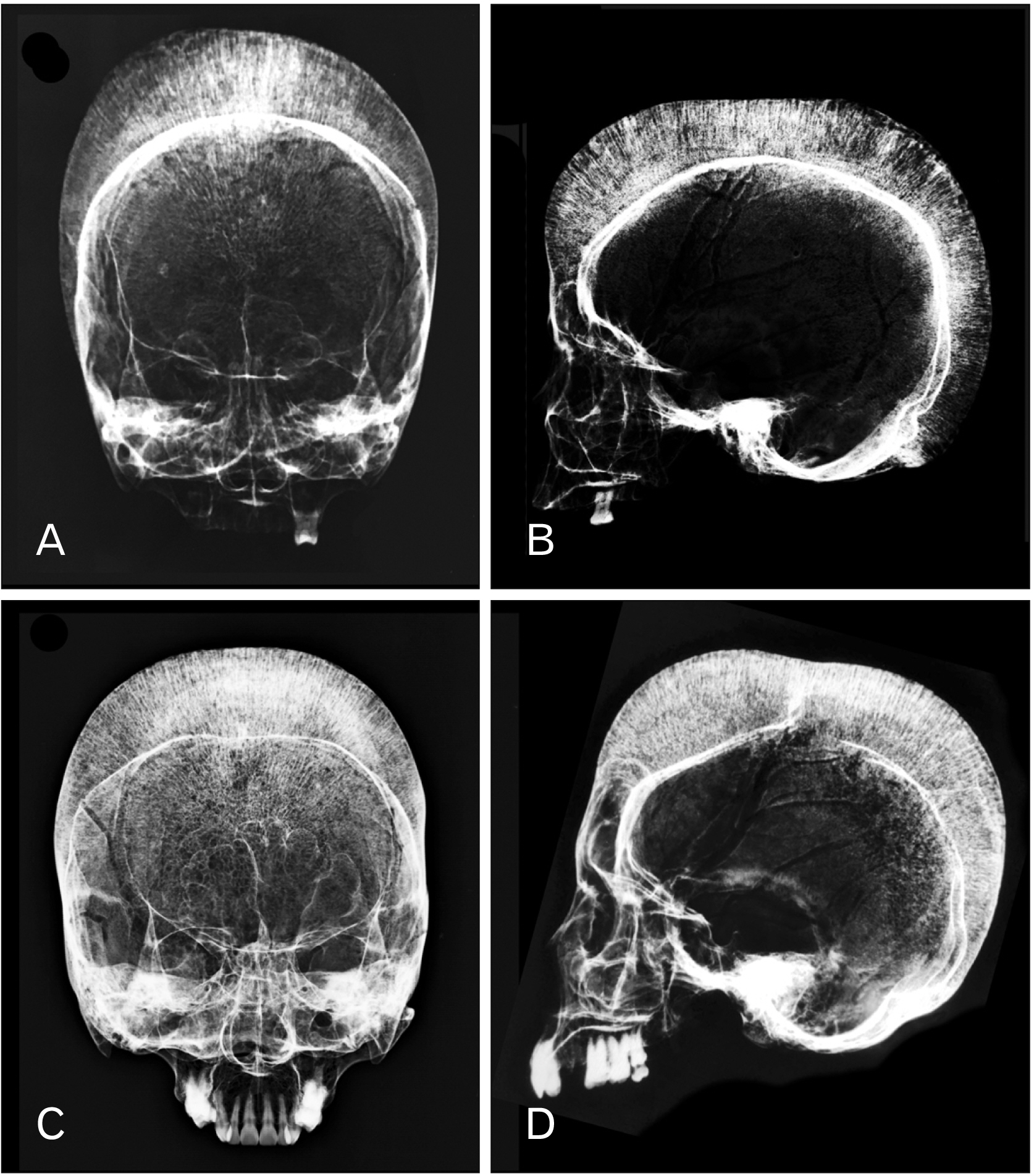Anat Cell Biol.
2021 Jun;54(2):280-284. 10.5115/acb.20.323.
Gross and radiographic appearance of porotic hyperostosis and cribra orbitalia in thalassemia affected skulls
- Affiliations
-
- 1Department of Anatomy, Faculty of Medicine, Khon Kaen University, Khon Kaen, Thailand
- 2Department of Anatomy, Faculty of Science, Mahidol University, Bangkok, Thailand
- KMID: 2516912
- DOI: http://doi.org/10.5115/acb.20.323
Abstract
- Porotic hyperostosis (PH) is the expansion of the cranial diploë, generating ‘hair-on-end’ appearance on X-rays. This condition is extremely rare and had a prevalence of 0.08%. It is alternatively known as cribra orbitalia (CO) when the orbital roof is affected. In this study, we describe the gross morphology of two skulls affected by PH and CO. The first skull belonged to a 41-year-old female previously diagnosed with beta thalassemia. The skull was affected by excessive PH and CO. The second skull, belonging to a 35-year-old male diagnosed with unspecified thalassemia, showed PH without CO. The etiology of PH and CO is discussed. In conclusion, PH and CO are extremely rare, and are of significant importance for radiologists and anatomists when interpreting radiographs or encountering unusual gross morphology of the skull.
Figure
Reference
-
References
1. Martin L, Rackard F. 2016; Images in Clinical Medicine. Hair-on-End Sign. N Engl J Med. 374:e23. DOI: 10.1056/NEJMicm1510045. PMID: 27168449.2. Rivera F, Mirazón Lahr M. 2017; New evidence suggesting a dissociated etiology for cribra orbitalia and porotic hyperostosis. Am J Phys Anthropol. 164:76–96. DOI: 10.1002/ajpa.23258. PMID: 28594081.3. Walker PL, Bathurst RR, Richman R, Gjerdrum T, Andrushko VA. 2009; The causes of porotic hyperostosis and cribra orbitalia: a reappraisal of the iron-deficiency-anemia hypothesis. Am J Phys Anthropol. 139:109–25. DOI: 10.1002/ajpa.21031. PMID: 19280675.
Article4. Cole G, Waldron T. 2019; Cribra orbitalia: dissecting an ill-defined phenomenon. Int J Osteoarchaeol. 29:613–21. DOI: 10.1002/oa.2757.
Article5. Cooley TB, Lee P. 1925; A series of cases of splenomegaly in children with anemia and peculiar bone changes. Trans Am Pediatr Soc. 37:29–30.6. Haidar R, Musallam KM, Taher AT. 2011; Bone disease and skeletal complications in patients with β thalassemia major. Bone. 48:425–32. DOI: 10.1016/j.bone.2010.10.173. PMID: 21035575.
Article7. Hoffman R, Benz E Jr, Shattil S, Furie B, Cohen HJ, Silberstein LE, McGlave P. 2005. Megablastic anemias. Hematology: Basic Principles and Practice. 4th ed. Churchill Livingstone;London:8. Resnick D, Niwayama G. 1988. Diagnosis of bone and joint disorders. 2nd ed. Saunders;Philadelphia:9. Lagia A, Eliopoulos C, Manolis S. 2007; Thalassemia: macroscopic and radiological study of a case. Int J Osteoarchaeol. 17:269–85. DOI: 10.1002/oa.881.
Article10. Keenleyside A, Panayotova K. 2006; Cribra orbitalia and porotic hyperostosis in a Greek colonial population (5th to 3rd centuries BC) from the Black Sea. Int J Osteoarchaeol. 16:373–84. DOI: 10.1002/oa.831.
Article11. McIlvaine BK. 2015; Implications of reappraising the iron-deficiency anemia hypothesis. Int J Osteoarchaeol. 25:997–1000. DOI: 10.1002/oa.2383.
Article12. Stuart-Macadam P. 1989; Porotic hyperostosis: relationship between orbital and vault lesions. Am J Phys Anthropol. 80:187–93. DOI: 10.1002/ajpa.1330800206. PMID: 2679121.
Article13. Sullivan A. 2005; Prevalence and etiology of acquired anemia in Medieval York, England. Am J Phys Anthropol. 128:252–72. DOI: 10.1002/ajpa.20026. PMID: 15795886.
Article
- Full Text Links
- Actions
-
Cited
- CITED
-
- Close
- Share
- Similar articles
-
- A case report of sternocostoclavicular hyperostosis: scintigraphic and the confirmative radiographic and CT findings
- A Case of Infantile cortical Hyperostosis
- Sternncostoclavicular hyperostosis: a case report
- Molecular basis and diagnosis of thalassemia
- Recurrence of Infantile Cortical Hyperostosis: A Case Report



